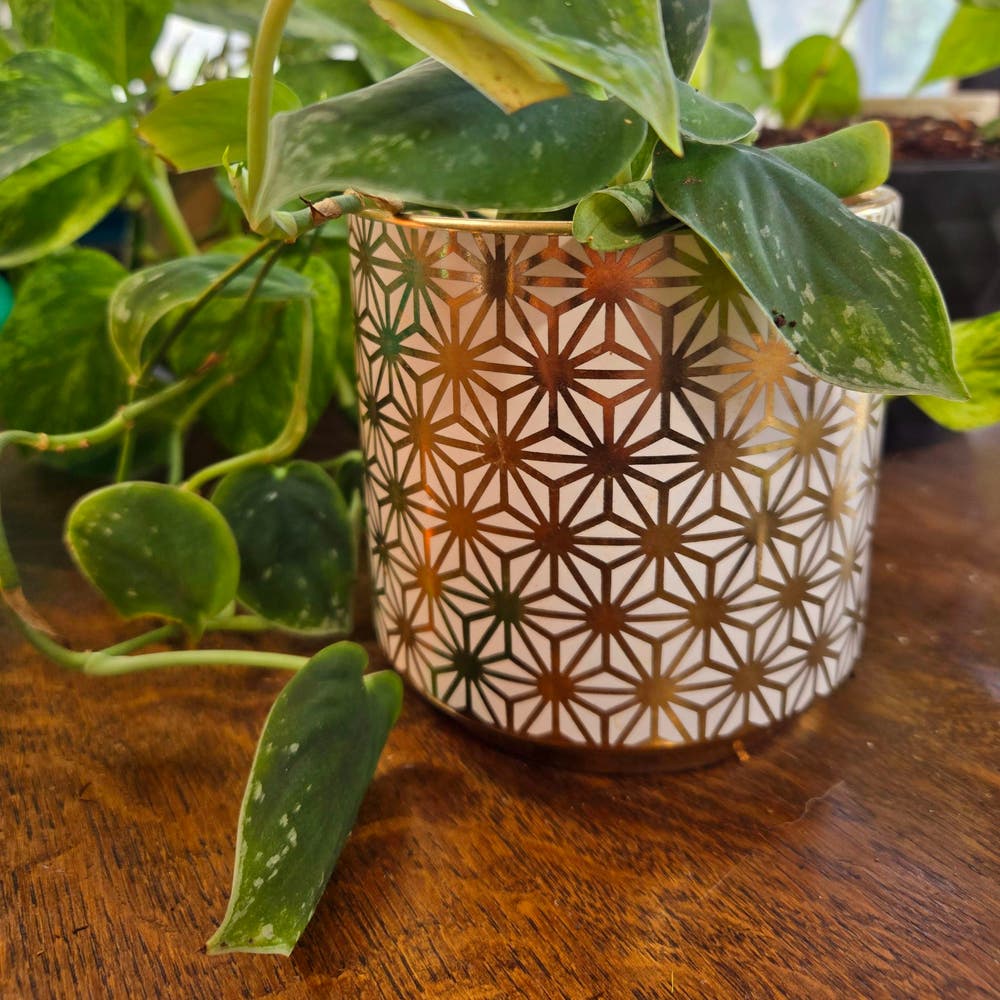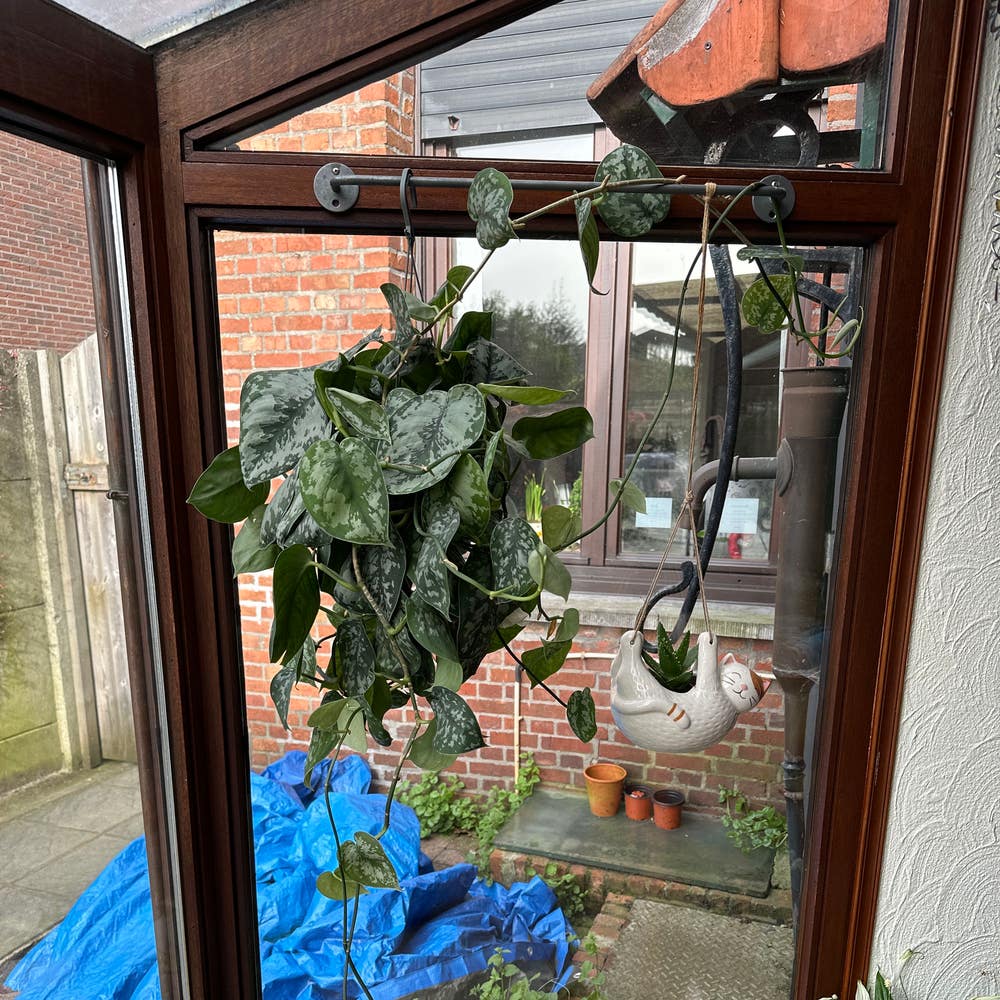Satin Pothos is Toxic To Humans
Dec 16, 2023•8 min read
Learn to love your Satin Pothos safely, avoiding its hidden toxic bite! 🌿⚠️
- Contains calcium oxalate crystals, causing irritation if ingested or touched.
- Symptoms include burning, swelling, and vomiting; seek medical attention if exposed.
- Preventive measures are crucial; keep out of reach and handle with care.
Identifying Satin Pothos (Scindapsus pictus)
Satin Pothos, or Scindapsus pictus, is a tropical charmer with a penchant for climbing. Its heart-shaped leaves are a canvas of deep green splashed with silvery splotches, giving it a shimmering effect that's hard to ignore.
🌿 Appearance and Growth Habits
This plant's vining nature makes it perfect for hanging baskets or training up moss poles, offering a versatile display of its fuzzy foliage. In the wild, it might flower, but don't hold your breath for blooms at home—it's a rare sight.
🌟 Popularity as a Decorative Plant
It's not just a pretty face; the Satin Pothos is a hardy survivor, making it a hit among indoor plant enthusiasts. Its unique foliage adds a splash of elegance to any room, and it's forgiving enough for those who don't possess a green thumb.
🌡️ Care Requirements
Thriving in temperatures between 65 to 75 °F, it's a plant that doesn't demand much. Just keep it away from the cold and give it a bigger pot when it gets root bound. It's a slow grower, so patience is a virtue with this one.
🌱 Varieties
While often confused with its cousin, the Golden Pothos, the Satin Pothos stands out with its silver variegation. Varieties like 'Argyreus' and 'Exotica' offer subtle differences in leaf size and pattern, but all share that signature sparkle.
Remember, while it's a joy to look at, keep it out of reach of curious pets—it's not as friendly as it looks.
Toxic Components
🌵 The Hidden Sting in the Green
Satin Pothos, while a visual delight, harbors a less welcome feature: insoluble calcium oxalate crystals. These microscopic troublemakers pack a punch when it comes to human health.
🕷 A Closer Look at the Culprit
These crystals are like nature's own version of miniature bear traps, lying in wait within the plant's tissues. Upon contact or ingestion, they spring into action, causing immediate discomfort and a slew of unpleasant reactions.
🚨 Health Risks Unveiled
The primary concern is oral irritation. Imagine a thousand tiny needles jabbing at your mouth's soft tissues—that's the kind of party calcium oxalate crystals throw. And it's not just a mouthful of misery; symptoms can escalate to swelling, difficulty swallowing, and in rare cases, respiratory issues.
📢 A Word to the Wise
It's crucial to handle Satin Pothos with care. Gloves are your best friends when pruning or repotting. And let's not turn a blind eye to the curious hands of children or the indiscriminate taste buds of pets—keep this plant out of their reach.
Symptoms of Satin Pothos Toxicity
When Satin Pothos (Scindapsus pictus) and humans don't mix well, the results can be less than ideal. Ingesting any part of this plant can lead to a nasty surprise for your mouth and throat. Think burning sensations and swelling that could make your next meal a challenge to enjoy.
🤒 Oral Irritation and Gastrointestinal Symptoms
- Burning in the mouth and throat
- Swelling of the tongue and lips
- Difficulty swallowing
- Vomiting and nausea
🩹 Dermatological Reactions
- Red rash or irritation upon skin contact
- Itching that makes you want to scratch your skin off
👀 Eye Irritation
- Tearing or discomfort if the sap gets in your eyes
🚑 Systemic Reactions
- In rare cases, kidney damage (from ingesting large amounts)
🚨 Immediate Actions
- Rinse mouth or skin with water
- Seek medical attention if symptoms persist or worsen
Remember, Satin Pothos isn't planning to launch a vendetta against you. But if you do tango with it the wrong way, it's best to have a doctor's number handy.
Managing Satin Pothos Toxicity
🛡️ Preventive Measures
Keep Satin Pothos plants on high shelves or in rooms that are off-limits to children and pets. This simple step can prevent a world of trouble. When handling the plant, wear gloves to dodge skin irritation—common sense for plant enthusiasts but a pro tip for the green-thumbed newbies.
🚸 Risks for Children and Pets
For households with mini humans or furry friends, vigilance is key. Create barriers or use strategic plant placement to ensure these curious explorers don't turn a peaceful plant corner into a hazard zone. Remember, the impact of Satin Pothos toxicity extends beyond immediate health concerns—it's about keeping your living space safe for all.
🤒 Risks for Sensitive Individuals
If you're the type that gets a rash from thinking about poison ivy, take extra care. Allergic reactions to Satin Pothos can be as mild as an itch or as severe as a full-blown skin revolt. If you suspect you're sensitive, handle with care, and if you react, manage it like any other allergy—avoidance is your best friend.
First Aid and Treatment
In the unlikely event that someone ingests Satin Pothos, don't wait for symptoms to show up. Call Poison Control at 1-800-222-1222 immediately. If the person is unconscious, having trouble breathing, or experiencing seizures, dial 911 without hesitation.
🚨 Immediate Steps for Ingestion
- Do not induce vomiting unless directed by a medical professional.
- Offer milk or water to the person if they're conscious and not having seizures.
- Keep a sample of the plant for identification purposes.
🚿 Immediate Steps for Skin Contact
- Rinse the affected skin area with lukewarm water for at least 15 minutes.
- Remove any contaminated clothing carefully.
Seeking Medical Advice
Always consult a healthcare provider for a proper diagnosis and treatment plan. Even if symptoms seem mild, don't take chances—some reactions may not be immediately apparent.
Remember, safety first: wear gloves when handling the plant to prevent skin irritation, and never touch your face during or after handling without washing your hands.
Debunking Myths and Misconceptions
Let's cut through the jungle of misinformation about Satin Pothos toxicity. It's time to separate fact from fiction when it comes to this popular houseplant's effects on humans.
🚫 Common Misconceptions
First off, Satin Pothos is not a salad. Despite its lush, green leaves, it's not meant for human consumption. The myth that houseplants like Satin Pothos can purify the air to a significant degree is also overblown. While they do contribute to a healthier environment, they're not a substitute for proper ventilation.
🦠 The Real Deal on Toxicity
Yes, Satin Pothos contains calcium oxalate crystals, which are indeed toxic. However, the plant poses a real danger only if ingested in large quantities. Skin contact might cause irritation, but it's not the end of the world—just wash the area with soap and water.
🧤 Handling the Plant
Contrary to some tall tales, you don't need to don a hazmat suit to handle Satin Pothos. Simple precautions like wearing gloves and washing your hands afterward will suffice. Keep the plant out of reach of children and pets, and you're golden.
🤒 Symptoms of Exposure
If someone tells you that brushing against Satin Pothos will cause you to break out in hives or lose your voice, take it with a grain of salt. Symptoms are usually mild unless someone decides to make a meal out of it. In that case, expect oral irritation, difficulty swallowing, and a possible trip to the doctor.
🎬 The Bottom Line
In essence, Satin Pothos is like that one movie everyone warns you about—it's not as scary once you know the facts. Treat it with respect, and it'll be a drama-free addition to your indoor garden.
Safe Handling and Care Practices
💪 Recommendations for Safe Practices
Wear gloves—this isn't a suggestion, it's a must. Satin Pothos, while easy on the eyes, is not so kind on the skin. The calcium oxalate crystals are the culprits here, causing irritation if you decide to go bare-handed.
Keep it high—out of reach of curious kids and pets. This isn't just about preventing a mess; it's about preventing a trip to the doctor or vet.
🌿 Tips for a Thriving Satin Pothos
Indirect light is your friend. Too much sun and your Satin Pothos's leaves might look like they've had a rough day at the beach. Too little, and the silver might as well be grey.
Don't drown it. Watering is a delicate dance—too much and you're setting the stage for root rot, too little and you'll have a wilted wallflower. Let the topsoil dry out a bit between waterings, and your Pothos will thank you.
Repot with care. Every couple of years, give your plant some new digs with fresh soil and a bit more space. It's like upgrading from a studio to a one-bedroom apartment—everyone breathes easier.
🌍 Environmental Impact
Non-native nuances—Satin Pothos isn't a local for most of us. If it gets out in the wild, it can be a bit of a bully to native plants. Keep it contained, and you're doing your part for the local flora.
Pesticide-free zone—if you're battling pests, go for natural remedies. Your Pothos, pets, and the planet will be better for it.
Remember, caring for a Satin Pothos is a bit like babysitting a gremlin—there are rules to follow for everyone's safety.


